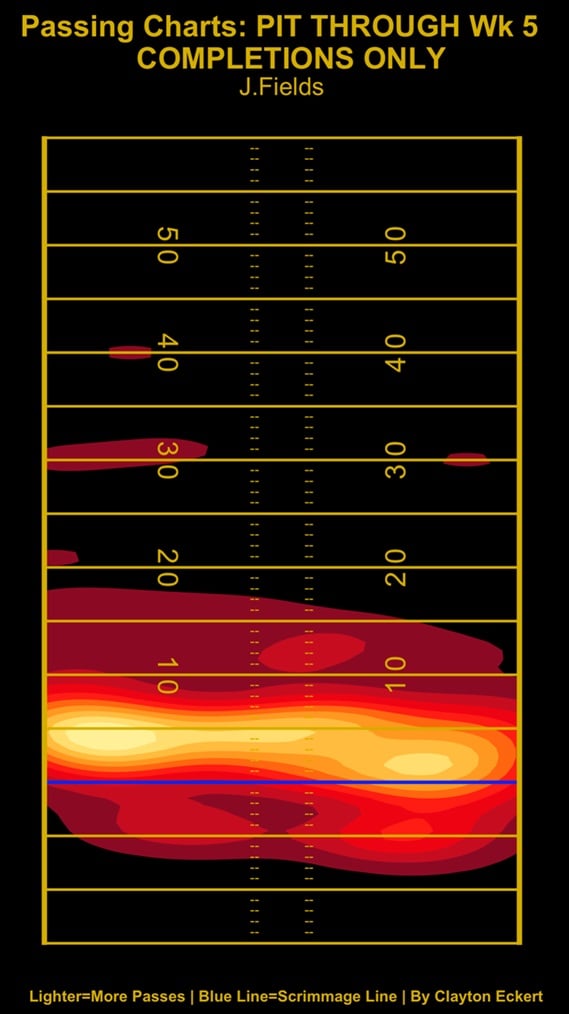The Pittsburgh Steelers now sit at 3-2 through Week Five, on a painful two-game losing streak. Simply, there have been too many issues on both sides of the ball, including the passing game.
A couple of notes before we jump in. Thanks to Thomas Mock for his great work, which helped me learn much about what I’m using in the visual series. Spikes and clear throwaways are removed due to being the correct situational decision, along with bats at the line of scrimmage. Two throwaways and a bat in this game.
QB Justin Fields went 15/27 for a 55.6 completion rate, his lowest of the season. That has been on a skid the last two games, at 64.7 percent in Week Four, compared to two prior games well above 70.0 earlier in 2024.
A positive first-time feat was multiple passing TDs (two) this week, connecting with TE Pat Freiermuth for the second game in a row, along with Connor Heyward. Tight end involvement, both in the red zone, was nice to see. No interceptions again, but had two near picks, one a final-seconds comeback effort.
Had another fumble, though it was G Isaac Seumalo in his 2024 Steelers debut getting blown back into Fields. Thankfully recovered though. Not as many rushing yards (27), but less sacks this game (two). Showed his toughness taking several hits, namely one on the chin earning unneccesary roughness, forcing Fields to exit the game for two plays.
This meant QB Kyle Allen got his first regular-season action. Russell Wilson served as the emergency QB3 in Week Five, and it will be interesting to see how much longer that lasts. Allen threw once on two snaps.
Let’s start with a simple view of the 25 charted passes, with the number of throws at each pass distance for Week 5:
#1. 0-5 air-yards: 44.0-percent. First example was an out route to WR George Pickens at three air yards, able to provide a bit of YAC on the opening drive. On third and two, empty formation for Fields, motioning RB Najee Harris to TE on 3rd and 2, running a flat route with churning YAC dragging a defender for 15 yards. Nice early conversion contributing to a FG.
Drive two started with eluding pressure and Fields targeting Heyward on a flat from FB alignment at five air yards, with good body control to make the jumping catch above his head for seven yards.
Then early second quarter, another TE Darnell Washington got involved, with Fields targeting his stop route at five air yards, hit quickly showing strong hands as the defender tried to strip it.
Next was in the third quarter and red zone, dealing with pressure from a free rusher, able to target Freiermuth at the line of scrimmage on a flat route but hit quickly for a loss of one. Then, several came in the final quarter, starting with a stop route connection with WR Van Jefferson.
Fields moved the pocket on the ensuing 3rd and 1, with a good find and throw to Heyward, stopping in the soft spot short over the middle, but the defender, unfortunately, punched it out for one of the several fails of the game. Harris’ 4th and 1 rush conversion extended this drive, though.
WR Brandon Johnson, who was elevated for the first time, got the crosser from Fields at four air yards and was able to pick up nine on the extended drive. Set up 3rd and 1, down three with six minutes. Fields makes a nice sidearm pass around the defender, getting it to Pickens on the pivot route at two air yards and turning that into explosive YAC and gain of 21 yards to the red zone.
Two plays later on the six-yard line, Fields drifted like a designed run but then flipped it to Freiermuth with good blocks in front for the go-ahead score with five minutes left. The pass distance was effective overall, including late game. The final desperation play (multiple laterals) is one exception, putting a damper on the offense’s final full drive.
#2. 5-10 air-yards: 28.0-percent. First example yet to be mentioned came in the third quarter, a stretch where Fields began looking more comfortable, ironically following his exit from the game with a stop route to Jefferson over the middle at six air yards, picking up seven.
The following drive included a sit route from WR Calvin Austin, also at six air yards, which was tackled quickly. The following 3rd and 4 was a big missed opportunity, with Fields delivering a bit high (free blitzer) to Pickens, a catchable out route that went off his hands. Ugh.
#3. Explosive (20-plus air-yards): 24.0-percent. More frequent than usual, but the short story is pain. Six attempts, no completions, yikes. Interestingly, 5/6 explosives were on first down.
The first pass of the game was a play-action boot, a great design to get Heyward open, leaking out from FB past the defender down the sideline. Fields is hit on the throw (T Broderick Jones) and goes a little long off his hands on the diving effort. Debatable drop, missed opportunity #1. Then another first drive attempts to Washington on a seam route red zone target and overthrew this mountain of a man substantially.
Next was the longest air-yard attempt of the game (36) in the second quarter. Example of bad decision-making noting others being open, Fields goes dangerously into double coverage, with the underthrow to Jefferson on the slot go nearly being intercepted. Fourth play also came in the first half. This 3rd and 5 was another poor decision missing open guy(s). Wanted Pickens who was well covered, and the pass broken up, although it did hit his hands.
Final two came much later in the fourth quarter. 6:56 left, Fields delivers a nice back-shoulder throw to Jefferson, a drop that goes off his hands and incomplete. This play and explosive air-yard passing was cringe-worthy this game. Final play was desperation mode in the waning moments (:15), his second near-interception into traffic, whoof.
#5. 10-15 air-yards: 16.0-percent. Four passes, with each in the second half. First was Kyle Allen’s lone attempt, a nice one to Freiermuth on a middle-of-the-field slant at 12 air yards, plus a nice churning YAC that gave the passing game some spark. Fields proceeded with two more on the same drive, starting with a nice in-breaker throw to Jefferson at 11 air yards, where he was tackled inside the red zone.
This drive was capped off with the team’s other touchdown, another great design where outside routes freed Heyward’s corner route to get wide open for the catch (12 air yards) and 16-yard score to claim the lead for the first time. The other was early fourth quarter, unfortunately back to miscues, with Fields well overthrowing the wide-open Pickens on a corner route.
T-3rd. Behind-the-Line: 4.0-percent. Just one this week, less than the season average. This was a very successful screen to Harris, using some good blocks in front to take the -5 air yarder for 20 yards, the first explosive play at 8:44 in the third quarter. Also was one of just two total explosives for Pittsburgh’s offense, barf.
#6. 15-20 air-yards: 0.0-percent. The typically underutilized distance (in my opinion) was ignored in Week Five.
Here are the dots of completions/incompletions for the game:
As I alluded to above, Fields going 0/6 explosives, really jumps out negatively. Longest completion was only 12 air yards, eek. Allen did that on just one throw, on the nice play over the middle to Freiermuth. With that low sample in mind, I will continue with Fields’ numbers for the rest of the article.
Completion Rates By Distance:
FIELDS:
Behind-the-line: 1/1 (100-percent).
0-5 air-yards: 10/11 (90.9-percent).
5-10 air-yards: 5/7 (71.4-percent).
10-15 air-yards: 2/3 (66.7-percent).
15-20 air-yards: 0/0 (N/A).
Explosive: 0/6 (0.0-percent).
Money at five air yards or less, then trailing off at intermediate distance, including no 15-20 targets. The explosive results are still there to haunt us as well.
Completion Rates By Location:
FIELDS:
Outside left numbers: 3/6 (50.0-percent).
Left numbers-left hash: 1/2 (50.0-percent).
Inside hashes: 1/1 (100-percent).
Right hash-right numbers: 6/8 (75.0-percent).
Outside right numbers: 4/7 (57.1-percent).
Outside the numbers was more of a struggle, which makes sense with the majority of explosives going there.
Now for the heat maps for charted passes, then completions only:
As you may have guessed from the dots, the heat maps look promising on all attempts but go dark on the completions-only view. While Fields’ job hasn’t been “gunslinger” to date, a 12-yard max completed air distance is his game-low of 2024 that must improve for competitive balance.
Here’s to that connection making a noticeable difference in the pass game moving forward while continuing to present the downfield threat on defenses, which could optimistically lead to more points soon as well.
Next, here’s a data recap of Fields’ 125 charted throws of the 2024 regular season:
#1. 0-5 air yards: 43.2-percent. Previously 42.6-percent. 2023 35.0-percent.
#2. 5-10 air yards: 28.0-percent. Previously 27.7-percent. 2023 23.8-percent.
#3. Behind-the-line: 14.4-percent. Previously 16.8-percent. 2023 18.5-percent.
#4. Explosive: 12.8-percent. Previously 9.9-percent. 2023 12.4-percent.
#5. 10-15 air yards: 10.4-percent. Previously 9.9-percent. 2023 13.0-percent.
#6. 15-20 air yards: 5.6-percent. Previously 6.9-percent. 2023 10.8-percent.
Explosives moved up a rank, but we know quantity doesn’t equal quality in the rough loss.
Completion Rates By Distance:
FIELDS:
Behind-the-line: 14/18 (77.8-percent).
0-5 air-yards: 48/54 (88.9-percent).
5-10 air-yards: 27/35 (77.1-percent).
10-15 air-yards: 7/13 (53.8-percent).
15-20 air-yards: 3/7 (42.9-percent).
Explosive: 5/16 (31.3-percent).
Completion Rates By Location:
FIELDS:
Outside left numbers: 31/44 (70.5-percent).
Left numbers-left hash: 11/16 (68.8-percent).
Inside hashes: 9/11 (81.8-percent).
Right hash-right numbers: 19/23 (82.6-percent).
Outside right numbers: 22/31 (71.0-percent).
To close, here are the dots and heat maps for all charted attempts, then completions only:
Thanks for reading, and let me know your thoughts in the comments.
















